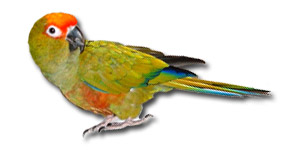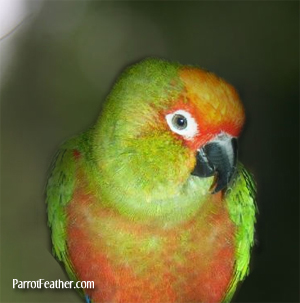|
Gold-capped
Conure
Common
Names: Gold-capped
Conure & Gold-cap Conure
Scientific
Name: Aratinga
auricapilla
Origin: South America—Southern Brazil
Relative Size: Small 140-150 grams
Average Lifespan: 20 – 30 years.
Feral and
Captive Behaviors:
The Gold-capped Conure is native to Brazil. These birds function
in flocks of 30 or more and are usually noticed through their loud
shrills. Together they forage and eat fresh blossoms or ripe
fruits. While in their natural habitat they nest in tree cavities
and choose roosting sites that are high.
At one time
these birds were abundant in Brazil; however, habitat destruction
has caused their numbers to decline. Nesting sites are now harder
to come across due to deforestation. Fortunately, they breed will
in captivity and have been established inside the pet trade.
Pet Aspect:
The Gold-capped Conure is a wonderful pet. They are common
amongst parrot breeders and can be found for reasonable prices.
They have wonderful personalities and are very affectionate
creatures. They have so much energy that finding time to play is
never a problem. To help burn their excess energy, these conures
need time outside their cage. Handfed babies will eagerly cling
to the side of the cage until they are let out and placed onto a
play stand.
Spending
time with their owners is essential to their psychological
health. They need to be interacted with daily. Placing your
conure on your shoulders is a great way to include him in your
activities. While watching television with you, this conure will
easily find a nice pocket or place to snuggle in.
Their antics
are quite amusing too. There is nothing more comical then
watching a conure play on its stand or move its head up and down.
They enjoy swinging, flapping, and chewing. Again, they are truly
active, and at times during relaxing moments it can be difficult
to keep them rested. Having some sort of distraction is great to
keep them still, such as wooden hand toys.
Talking:
Though conures are not known for their talking ability, the
Gold-capped conure can speak. Their clarity is not as clear as an
Indian Ringneck; however, their voices are somewhat
understandable. Most owners describe their voices as sounding
muffled and high pitched. It is not uncommon to hear these
parrots speak 20 or more words.
Appearance:
The Gold-capped Conure is a brightly colored parrot. It belongs
to the Genus Aratinga, a taxonomic group that has conures that look
similar and have similar physical traits. Members inside the
group include the Jenday Conure, Sun Conure, and the
Golden-fronted Conure. Like most conures inside this genus, full
coloring is not apparent until the conure reaches about a year of
age.
the Genus Aratinga, a taxonomic group that has conures that look
similar and have similar physical traits. Members inside the
group include the Jenday Conure, Sun Conure, and the
Golden-fronted Conure. Like most conures inside this genus, full
coloring is not apparent until the conure reaches about a year of
age.
Though not
as bright as the Sun Conure, the Gold-capped Conure has some
similar colorings. For example, the cap is golden and highlighted
by a red band above the forehead and around the eyes. Their
bodies are green but hues of aqua can be seen in direct sunlight.
Red underlines the wings and above the thighs. Interspersed
between the underside of the green wings and black feathers, a
bright golden band is present. The eyes are surrounded by a white
ring and the feet and beak are black. The tail has hues of
yellow, green, and blue mixed.
The birds
are dimorphic which means they cannot be sexed visually.
Problems:
Conures can be loud. Their calls are sharp and piercing. To
avoid turning your conure into a screamer, proper techniques
should be used to help minimize screaming. These parrots cannot
be expected to keep quiet during their natural calling times,
which is during the morning, noon, and before sun set.
Like most
parrots, these conures can become nippy. To avoid biting, set
ground rules from day one and continually distract your conure if
you think you will be bitten. Never encourage nibbling or soft
preening of the skin. Never react to a sudden bite because this
can reinforce the bad trait.
|
|
Diet:
Your conure’s diet needs to be healthy if you expect him to reach
an old age. A diet of seeds will only keep your conure alive for
10 years. Seeds are high in fat and therefore should be given in
moderation. The best remedy is giving your conure a mixture of
pellets and seeds. Substitute fruits and vegetable daily. Fresh
fruits and vegetables offer the conure natural unprocessed
nutrients that are healthy for him.
|
|


